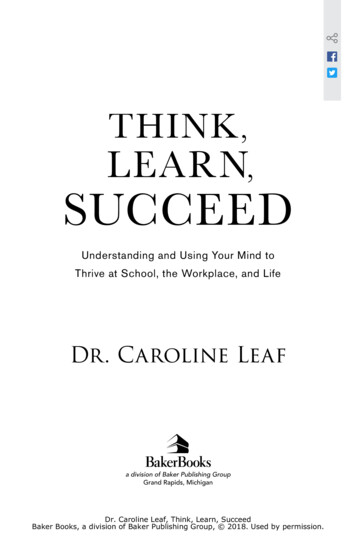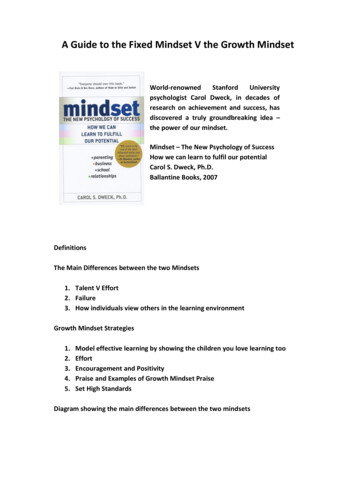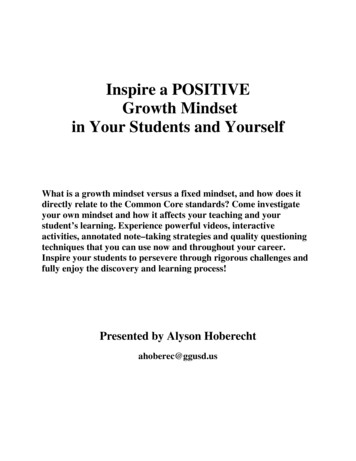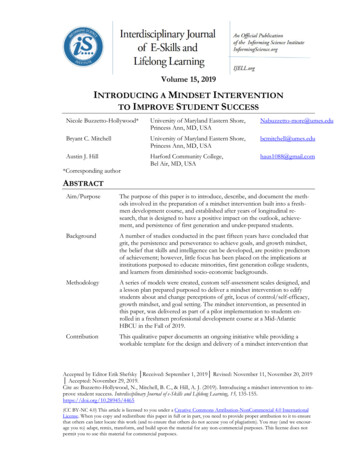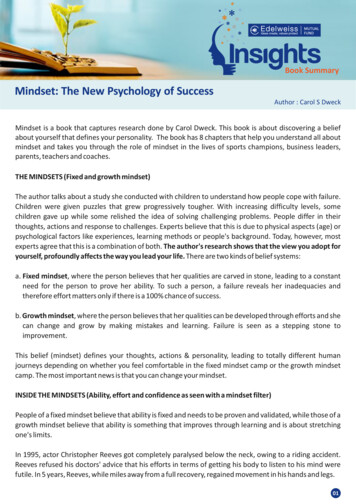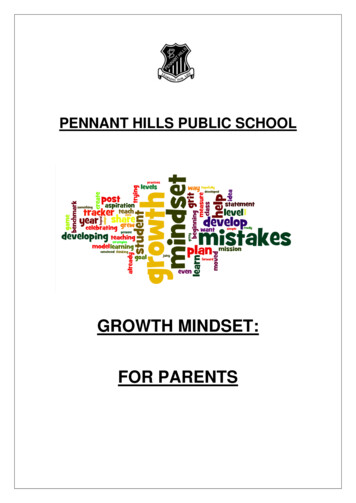
Transcription
Growth mindset tempers the effects of poverty onacademic achievementSusana Claroa,1, David Pauneskub, and Carol S. Dweckb,1aGraduate School of Education, Stanford University, Stanford, CA 94305-3001; and bDepartment of Psychology, Stanford University, Stanford,CA 94305Two largely separate bodies of empirical research have shownthat academic achievement is influenced by structural factors, suchas socioeconomic background, and psychological factors, such asstudents’ beliefs about their abilities. In this research, we use anationwide sample of high school students from Chile to investigate how these factors interact on a systemic level. Confirmingprior research, we find that family income is a strong predictorof achievement. Extending prior research, we find that a growthmindset (the belief that intelligence is not fixed and can be developed) is a comparably strong predictor of achievement and thatit exhibits a positive relationship with achievement across all ofthe socioeconomic strata in the country. Furthermore, we find thatstudents from lower-income families were less likely to hold agrowth mindset than their wealthier peers, but those who didhold a growth mindset were appreciably buffered against the deleterious effects of poverty on achievement: students in the lowest10th percentile of family income who exhibited a growth mindset showed academic performance as high as that of fixed mindsetstudents from the 80th income percentile. These results suggest thatstudents’ mindsets may temper or exacerbate the effects of economicdisadvantage on a systemic level.mindset academic achievement income inequality education equalitySocioeconomic background is one of the strongest, bestestablished predictors of academic achievement (1, 2). It iswell-known that economic disadvantage can depress students’academic achievement through multiple mechanisms, includingreduced access to educational resources, higher levels of stress,poorer nutrition, and reduced access to healthcare (3–5). Nonetheless, students with the same economic background clearly vary intheir academic outcomes, and researchers have long suggested thatstudents’ beliefs, such as locus of control, may temper or exacerbatethe effects of economic disadvantage on academic achievement (6–9). However, there has been a lack of clarity as to what these beliefsare or how they interact with structural factors, like economic disadvantage, on a systemic level. The current research identifies abelief—students’ mindset about intelligence—that is systematicallyassociated with economic disadvantage and moderates its effects onachievement. Importantly, it is also a belief that is potentiallyamenable to change (10–14).Numerous studies have found that students fare better if theybelieve that their intellectual abilities can be developed—a beliefcalled growth mindset—than if they believe that their intellectualabilities are immutable—a belief called fixed mindset (15). Thesestudies have documented numerous ways in which mindsets influence behaviors that impact academic achievement (16–18).Students with a fixed mindset tend to avoid situations in whichthey might struggle or fail because these experiences underminetheir sense of their intelligence. In contrast, students who have agrowth mindset tend to see difficult tasks as a way to increasetheir abilities (11) and seek out challenging learning experiencesthat enable them to do so (16, 17). As a consequence, studentswho have a growth mindset tend to earn better grades thanstudents who hold a fixed mindset (11, 17, 18), especially in theface of difficulty. Additionally, a number of field 07113have now shown that growth mindset plays a causal role inachievement. These field experiments, including two blinded,randomized, controlled studies conducted with over 1,500 participants each, have shown that targeted interventions can helpstudents start to develop a growth mindset and that such interventions can lead to higher achievement for students facinggreater adversity (10–14).However, because previous research was conducted with unrepresentative samples and lacked socioeconomic data, it hasbeen impossible for researchers to address fundamental questions about the relationship between mindset and socioeconomicachievement gaps. Is the relationship between mindset and academic achievement a lawful pattern that can be observed reliablyacross an entire nation, and is it strong enough to be practicallymeaningful when measured against canonical structural factors,like family income? Is there evidence that economic disadvantagereinforces the fixed mindset? Finally, is a fixed mindset even moredeleterious to economically disadvantaged students because theymust overcome greater obstacles to succeed? We systematicallyinvestigate these questions for the first time, to our knowledge,using a national dataset containing all 10th graders in Chile.Materials and MethodsThis work uses a dataset of all 10th grade public school students in Chile toaddress these questions on a national scale. The Chilean Government administers standardized tests to measure the mathematics and language skillsof all 10th graders in the country every other year. It also surveys eachSignificanceThis study is the first, to our knowledge, to show that a growthmindset (the belief that intelligence is not fixed and can be developed) reliably predicts achievement across a national sample ofstudents, including virtually all of the schools and socioeconomicstrata in Chile. It also explores the relationship between incomeand mindset for the first time, to our knowledge, finding thatstudents from lower-income families were less likely to hold agrowth mindset than their wealthier peers but that those who didhold a growth mindset were appreciably buffered against thedeleterious effects of poverty on achievement. These resultssuggest that mindsets may be one mechanism through whicheconomic disadvantage can affect achievement.Author contributions: S.C. designed research; S.C. and C.S.D. performed research; S.C. andD.P. analyzed data; S.C., D.P., and C.S.D. wrote the paper; and S.C., D.P., and C.S.D.designed figures.Reviewers: R.A.T., University of California, Davis; and T.D.W., University of Virginia.The authors declare no conflict of interest.Data deposition: The original datasets used for this study belong to the Chilean Department of Education. Applications to access these datasets should be done at nales/ for the SIMCE datasets. TheJUNAEB dataset can be downloaded directly from their site at xlsx.1To whom correspondence may be addressed. Email: sclaro@stanford.edu or dweck@stanford.edu.This article contains supporting information online at 113/-/DCSupplemental.PNAS Early Edition 1 of 5PSYCHOLOGICAL ANDCOGNITIVE SCIENCESContributed by Carol S. Dweck, May 25, 2016 (sent for review September 27, 2015; reviewed by Ross A. Thompson and Timothy D. Wilson)
Table 1. Unconditional Pearson correlations between keyvariables and standardized achievement test scoresVariableStudent-level variablesMindsetFamily incomeNatural log offamily incomeMother years ofeducationFather years ofeducationSchool-level variablesAverage mindsetin schoolPoverty indexSES quintileSchool mathematics2010School language2010LanguageMathematicsAveragelanguage .516 0.4120.4020.486 0.5200.5080.625 0.5120.5000.6100.5250.5280.578All values reported are significant (P 0.001). Details about each variableare in SI Materials and Methods. SES, socioeconomic status.student, each student’s family, and each school. The 2012 student survey forthe first time, to our knowledge, measured students’ mindsets about themalleability of intelligence using a short version of the standard instrumentused by Dweck (15). Students who agreed or strongly agreed with statements suggesting that intelligence cannot be changed (i.e., “intelligence issomething that cannot be changed very much” and “you can learn newthings, but you can’t change a person’s intelligence”) were categorized ashaving a fixed mindset, those who disagreed or strongly disagreed werecategorized as having a growth mindset, and those who were uncertainwere categorized as having a mixed mindset. A categorical system was usedin graphical presentations for clarity, whereas a continuous standardizedscore was used in analyses. The details, including the Spanish translation ofthe items, are provided in SI Materials and Methods.The analyses include all public school students who answered at least onemindset item and completed at least one standardized test (n 168,203 andn 168,553 for mathematics and language, respectively). These studentsrepresent 75% of all 10th graders from Chile’s public schools, and theschools represent 98% of all 2,392 public schools. A detailed description ofthe population as well as the imputation methods that were used formissing data are available in SI Materials and Methods. The descriptivestatistics for variables on the whole population and the analytical sample arelisted in Table S1.ResultsFirst, we sought to determine whether the relationship betweenmindset and academic achievement constitutes a lawful patternthat can be observed reliably across an entire nation and whetherit is strong enough to be practically meaningful when measuredagainst canonical structural factors, like family income. Consistent with prior findings (1, 19), canonical predictors of academicachievement, such as family income and parents’ education, werecorrelated with test scores in our sample (Table 1). Importantly,the relationship between student mindsets and achievement wascomparably strong and held across all students in Chile. Studentmindset explained 11.8% of variance (r 0.343) in a compositeaverage of mathematics and language scores, and the top student-level socioeconomic predictor explained 11.3% (r 0.336).The difference between these correlations was statistically significant: Fisher’s r to Z 2.29; P 0.02 (20). Among school-levelsocioeconomic variables, the poverty concentration index wasthe strongest predictor of test scores (explaining 26.2% of variance), whereas the average mindset at the school—or “school2 of 5 t”—was again on par with this variable (explaining 26.6%of the variance). This difference was not statistically significant:Fisher’s r to Z 1.58; P 0.11.Second, we sought to determine the robustness and generalizability of this relationship. We found that the relationship between mindset and achievement could be observed across thesocioeconomic spectrum and even when controlling for an extensive list of important student- and school-level factors. As Fig. 1shows, students who subscribed to a growth mindset outperformedtheir peers at each family income level. Furthermore, mindsetremained a highly significant predictor of achievement across aseries of hierarchical linear regression models (21) controllingfor all available canonical predictors of achievement (1, 19, 22).Table 2 presents the results, showing that the relationship between mindset and test scores still holds in each of these models.To start, column 2 in Table 2 shows this analysis for standardizedmathematics and language scores without any covariates. Column3 in Table 2 controls for student-level characteristics, includinggender, ethnic origin, family income, mother’s and father’s educations, the presence of household assets (e.g., books, computer),and family structure. Column 4 in Table 2 further adds schoollevel variables, including the socioeconomic level of the school,school enrollment, average class size, type of administration,urbanicity, geographic region, and the school’s 2010 averagemathematics and language test scores. With all of these importantcovariates included, the model accounted for almost all of thevariability of scores between schools (93–95% depending on thesubject) and 36–44% of the total variance; however, the estimateof the mindset effect on achievement remained significant (B 0.203; SE 0.002; P 0.001 for language and B 0.138; SE 0.002; P 0.001 for mathematics). The estimated coefficientssuggest that, on average, the academic growth associated with astudent who changes from having a fixed mindset to a mixedmindset or from a mixed mindset to a growth mindset is 0.2 SDson language test scores and 0.13 SDs on mathematics test scores.We also considered the possibility of reverse causation—perhaps doing well in school leads to a growth mindset rather thanthe other way around. That is, students who do well may holdpositive self-perceptions, such as believing themselves to be intelligent, accomplished students. It is plausible that these positiveself-perceptions could lead to other positive beliefs, such as thebelief that their intellectual ability can grow over time. To testfor reverse causation, we ran the previous model and addedcontrols for a variety of beliefs and expectations that could play arole in this reverse causal process. These beliefs included students’ self-assessments of their intelligence and their ability ineach subject, such as agreement with the statements “I amsmart,” “I am better than the majority of my classmates onmathematics tests,” and “I do well in language arts.” We alsocontrolled for student’s and parents’ expectations of the student’s academic attainment and the degree to which the student liked each subject area and thought that it was important.The relationship between mindsets and achievement remainedhighly significant when controlling for these factors (B 0.171;P 0.001 for language and B 0.119; P 0.001 for mathematics).Thus, our effect is not because of the fact that students who seethemselves as doing well simply observe their academic growthand come to the conclusion that intelligence can be developed.An additional model was created to assess the reliability of therelationship between mindset and achievement across each individual school. To calculate a range of plausible values for the mindseteffect per school, the model included a school-level random component for the mindset coefficient as well as all student- and schoollevel control variables. Through this analysis, we estimate a positiveassociation between mindset and achievement for each of 2,339schools included in the sample (the 95% plausible value range forthe association between mindset and language per school was 0.077–0.261, and the 95% plausible value range for the association betweenClaro et al.
mindset and mathematics per school was 0.038–0.200). Details are inSI Materials and Methods.Consistent with prior experimental studies, our results showthat, for students with the same observable characteristics, thosewith a growth mindset achieved at higher levels than those with afixed mindset. Furthermore, these results show for the first time,to our knowledge, that this relationship is comparably strongwith that between family income and achievement and that itholds true systemically—across an entire nation’s socioeconomicspectrum and across virtually all of its schools.A final series of models investigated the prevalence of mindsetsas a function of income as well as the relationship between incomeand achievement as a function of mindset. First, we tested thepossibility that economic disadvantage and the limited structuralopportunities associated with it could themselves reinforce a fixedmindset. A simple correlation revealed that students’ mindsets andfamily income were, indeed, linked (r 0.17; P 0.001). At theextremes, students from the lowest-income families were twice aslikely to endorse a fixed mindset as students from the top-incomefamilies and schools (Fig. 2).Second, we tested whether a fixed mindset was even moreharmful to the academic achievement of economically disadvantaged students because those students, lacking the resources ofhigher-income students, would need to overcome greater obstaclesto succeed. A negative interaction between family income (standardized) and mindset in predicting test scores (B 0.020; P 0.001 and B 0.018; P 0.001 for language and mathematics,respectively, which is shown in SI Materials and Methods, Table S2)suggested that lower income magnifies the deleterious effects ofa fixed mindset or, conversely, that a growth mindset may helpTable 2. Language and mathematics test scores predicted by mindset score (standardized) when controlling forstudent- and school-level variablesVariablesLanguage scoreMindset regression coefficientSEStudent controlsSchool controlsNo. of studentsNo. of schoolsMathematics scoreMindset regression coefficientSEStudent controlsSchool controlsNo. of studentsNo. of schoolsTest score predictedby mindset withno other ,339Test score predictedby mindset andstudent-level 2Included168,2032,339Test score predictedby mindset andboth student- andschool-level 138*0.002IncludedIncluded168,2032,339Each column describes a maximum likelihood hierarchical linear model with students nested in schools. Column 2 presents mindsetstandardized regression coefficients without any control variables. Column 3 adds student-level controls. Column 4 adds school-levelcontrols. Full list of controls is available in SI Materials and Methods, Table S1.*Regression coefficients are P 0.01.Claro et al.PNAS Early Edition 3 of 5PSYCHOLOGICAL ANDCOGNITIVE SCIENCESFig. 1. Average standardized mathematics and language test scores for students with growth and fixed mindsets by family income decile. A shows language scores, andB shows mathematics scores. Dashed lines represent students with growth mindset, and solid lines represent students with fixed mindset. For clarity, only fixed mindsetand growth mindset (not mixed mindset) students are included. However, we note that mixed mindset students consistently fell in between the two other groups.
Fig. 2. Percentage of students with fixed and growth mindsets as a function of family income. Percentages do not add up to 100 at each income decilebecause, for clarity, only fixed mindset and growth mindset (not mixed mindset) students are included. However, we note that the percentage of mixedmindset students consistently fell in between the two other groups. Families reported their income by selecting one income range from a list. Some incomedeciles are missing because on the questionnaires, parents were not offered an income choice corresponding to that decile.mitigate the negative effects of economic deprivation on academicachievement. This difference is illustrated in Fig. 1, where we observe that, strikingly, students from low-income families (the lowest10%) who had a growth mindset showed comparable test scoreswith fixed mindset students whose families earned 13 times more(80th percentile).were more likely to endorse a fixed mindset, this finding does suggestthat economic disadvantage may lead to poorer academic outcomes,in part by leading low-income students to believe that they cannotgrow their intellectual abilities. The observation that mindset is amore important predictor of success for low-income students thanfor their high-income peers is novel, although it is consistent withprior research, which has found that a fixed mindset is more debilitating (and a growth mindset is more protective) when individualsmust overcome significant barriers to succeed (13, 14).To be clear, we are not suggesting that structural factors, likeincome inequality or disparities in school quality, are less importantthan psychological factors. Nor are we saying that teaching studentsa growth mindset is a substitute for systemic efforts to alleviatepoverty and economic inequality. Such claims would stand at oddswith decades of research and our own data. Rather, we are suggesting that structural inequalities can give rise to psychologicalinequalities and that those psychological inequalities can reinforcethe impact of structural inequalities on achievement and futureopportunity. As such, research on psychological factors can helpilluminate one set of processes through which economic disadvantage leads to academic underachievement and reveal ways tomore effectively support students who face additional challengesbecause of their socioeconomic circumstances.DiscussionThe results of this study speak to researchers, educators, and policymakers interested in understanding equality of opportunity. Wedocument for the first time, to our knowledge, on a national scale arobust relationship between students’ mindsets about intelligenceand their academic performance. Our research shows that, at everysocioeconomic level, those who hold more of a growth mindsetconsistently outperform those who do not—even after holding constant a panoply of socioeconomic and attitudinal factors. The relationship between mindset and achievement holds true across all ofChile’s schools and across all levels of family income. In other words,for any two students with equal characteristics, the one endorsing agrowth mindset is more likely to enjoy higher academic achievement,suggesting that the benefit of having a growth mindset holds widely.Furthermore, these robust, nation-level correlations are complemented by multiple prior randomized field experiments showingthat a growth mindset has a causal impact on achievement (10–14).These findings also document for the first time, to our knowledge,a relationship between mindsets and economic disadvantage. Thelowest-income Chilean students were twice as likely as the highestincome students to report a fixed mindset, and their mindset was aneven stronger predictor of success for these low-income students.Although existing data cannot explain why low-income studentsACKNOWLEDGMENTS. We thank the team at the Agencia de Calidad atthe Chilean Department of Education for their valuable support. Thanks toS. Loeb, T. Dee, B. Lara, R. Valentino, D. Yeager, B. Shear, K. Castellano,S. Brady, B. Donovan, L. Quay, K. Shores, M. Kraft, S. Reardon, L. M. Budge,T. Wilson, and R. Thompson for helpful input. This research was funded, inpart, by Raikes Foundation Grant 227 (to the Stanford University Projectfor Education Research That Scales).1. Coleman JS, et al. (1966) Equality of Educational Opportunity (US GovernmentPrinting Office, Washington, DC), pp 1066–5684.2. Reardon SF (2011) The widening of the socioeconomic status achievement gap: Newevidence and possible explanations. Whither opportunity? Rising inequality, schools, andchildren’s life chances, eds Duncan GJ, Murnane RJ (Russell Sage Foundation, New York),pp 91–116.3. Evans GW, Schamberg MA (2009) Childhood poverty, chronic stress, and adult workingmemory. Proc Natl Acad Sci USA 106(16):6545–6549.4. Brooks-Gunn J, Duncan GJ (1997) The effects of poverty on children. Future Child 7(2):55–71.5. Thompson RA (2014) Stress and child development. Future Child 24(1):41–59.6. Coleman JS (1966) Equal schools or equal students? Public Interest (4):70–75.7. Finn JD, Rock DA (1997) Academic success among students at risk for school failure.J Appl Psychol 82(2):221–234.8. Lefkowitz MM, Tesiny EP, Gordon NH (1980) Childhood depression, family income, andlocus of control. J Nerv Ment Dis 168(12):732–735.9. Butterfield EC (1964) Locus of control, test anxiety, reactions to frustration, and achievement attitudes1. J Pers 32(3):355–370.10. Aronson J, Fried CB, Good C (2002) Reducing the effects of stereotype threat onAfrican American college students by shaping theories of intelligence. J Exp SocPsychol 38(2):113–125.11. Blackwell LS, Trzesniewski KH, Dweck CS (2007) Implicit theories of intelligence predictachievement across an adolescent transition: A longitudinal study and an intervention.Child Dev 78(1):246–263.12. Good C, Aronson J, Inzlicht M (2003) Improving adolescents’ standardized test performance:An intervention to reduce the effects of stereotype threat. J Appl Dev Psychol 24(6):645–662.13. Paunesku D, et al. (2015) Mind-set interventions are a scalable treatment for academic underachievement. Psychol Sci 26(6):784–793.14. Yeager DS, et al. (2016) Using design thinking to make psychological interventionsready for scaling: The case of the growth mindset during the transition to high school.J Educ Psychol 108(3):374–391.15. Dweck CS (2000) Self-Theories: Their Role in Motivation, Personality, and Development(Psychology, Philadelphia).16. Mueller CM, Dweck CS (1998) Praise for intelligence can undermine children’s motivation and performance. J Pers Soc Psychol 75(1):33–52.4 of 5 www.pnas.org/cgi/doi/10.1073/pnas.1608207113Claro et al.
21. Raudenbush SW, Bryk AS (2002) Hierarchical Linear Models: Applications and DataAnalysis Methods (Sage Publications, Thousand Oaks, CA), 2nd Ed.22. Lara B, Mizala A, Repetto A (2011) The effectiveness of private voucher education: Evidencefrom structural school switches. Educ Eval Policy Anal 33(2):119–137.23. Agencia de Calidad (2013) Metodología de Construcción de Grupos SocioeconómicosPruebas SIMCE 2012. Available at icos-SIMCE-2012.pdf.Accessed July 20, 2015.PSYCHOLOGICAL ANDCOGNITIVE SCIENCES17. Romero C, Master A, Paunesku D, Dweck CS, Gross JJ (2014) Academic and emotional functioning in middle school: The role of implicit theories. Emotion 14(2):227–234.18. Stipek D, Gralinski JH (1996) Children’s beliefs about intelligence and school performance. J Educ Psychol 88(3):397–407.19. Mizala A, Romaguera P, Urquiola M (2007) Socioeconomic status or noise? Tradeoffsin the generation of school quality information. J Dev Econ 84(1):61–75.20. Zar JH (1996) Biostatistical Analysis (Prentice Hall, Upper Saddle River, NJ), 3rd Ed.Claro et al.PNAS Early Edition 5 of 5
Growth mindset tempers the effects of poverty on academic achievement Susana Claroa,1, David Pauneskub, and Carol S. Dweckb,1 aGraduate School of Education, Stanford University, Stanford, CA 94305-3001; and bDepartment of Psychology, Stanford University, Stanford, CA 94305 Contributed by Carol S. Dweck
